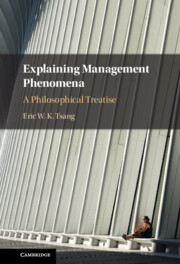Book contents
- Explaining Management Phenomena
- Explaining Management Phenomena
- Copyright page
- Contents
- Figures and Tables
- Preface
- Articles
- Chapter 1 The Nature of Explanation
- Chapter 2 Causation
- Chapter 3 Modes of Explanation
- Chapter 4 Microfoundations
- Chapter 5 Theory versus Non-theory–Based Explanation
- Chapter 6 Multi-theoretical Explanation
- Chapter 7 Research Methods
- Chapter 8 Explanation as Science (or Art?)
- Appendix Chinese Philosophy and Scientific Research
- Notes
- References
- Index
- References
References
Published online by Cambridge University Press: 15 December 2022
- Explaining Management Phenomena
- Explaining Management Phenomena
- Copyright page
- Contents
- Figures and Tables
- Preface
- Articles
- Chapter 1 The Nature of Explanation
- Chapter 2 Causation
- Chapter 3 Modes of Explanation
- Chapter 4 Microfoundations
- Chapter 5 Theory versus Non-theory–Based Explanation
- Chapter 6 Multi-theoretical Explanation
- Chapter 7 Research Methods
- Chapter 8 Explanation as Science (or Art?)
- Appendix Chinese Philosophy and Scientific Research
- Notes
- References
- Index
- References
Summary

- Type
- Chapter
- Information
- Explaining Management PhenomenaA Philosophical Treatise, pp. 226 - 252Publisher: Cambridge University PressPrint publication year: 2022

